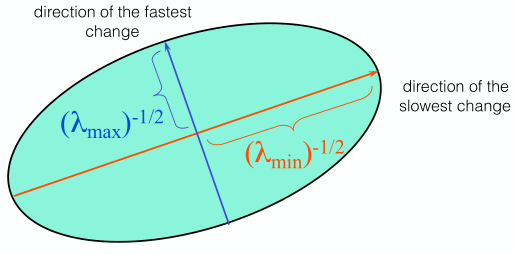1.4. Corner Detection#
Motivation: shifting a window W in any direction should give a large change in intensity.
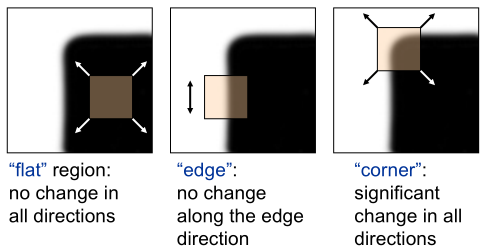
Math background#
Correlation#
Given \(\textbf{f - image, h - kernel}\)
cross correlation
auto correlation
Normalized cross correlation
Summed square difference (SSD)#
This is used in template matching. See Correspondence Matching
Relation between SSD and cross correlation#
Harris Corner Detection#
Error function#
Change in appearance of window \(w\) for the shift \((u, v)\):
First-order Taylor approximation for small shifts \((u, v)\) :
Let’s plug this into \(E(u, v)\):
Second moment matrix#
This matrix is weighted sum of nearby gradient information (could use Gaussian weighting).
Visualization of a quadratic#
From previous section, \(E(u, v)\) is locally approximated by a quadratic form.

Since \(M\) is symmetric, \(M\) could be diagonalized as
Eigenvalues interpretation#

Take-away
\(\lambda_{1}\) and \(\lambda_{2}\) both small: no gradient
\(\lambda_{1} \gg \lambda_{2}\) : gradient in one direction
\(\lambda_{1}\) and \(\lambda_{2}\) similarly large: multiple gradient directions, corner
Threshold on a function of eigenvalues#
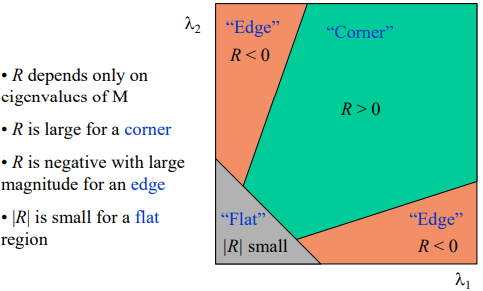
Corner response \(R\)
If these estimates are large, \(\lambda_{1}\) and \(\lambda_{2}\) are similarly large.
Summary#
Source code: C++ and Python implementation.
Intensity change in direction [u,v] can be expressed as a bilinear form:
Compute corner response for each point in terms of eigenvalues of \(M\)
A good corner should have a large intensity change in all directions, i.e. R should be large positive.
Pipeline
Compute partial derivatives \(I_{x}\) and \(I_{y}\) at each pixel
Compute products of derivatives at every pixel
Compute the sums of the products of derivatives at each pixel
Compute second moment matrix \(M\) in a Gaussian window around each pixel
Compute corner response function \(R=\operatorname{det}(M)-\alpha \operatorname{trace}(M)^{2}\)
Threshold \(R\)
Find local maxima of response function (NMS)
Implementaion in Jupyter#
Step1: Image gradients#
image = io.imread(fname="../../data/ass3/rice.png")
h,w = image.shape
# keep the output datatype to some higher forms
Ix = cv.Sobel(image,cv.CV_64F,1,0,ksize=1)
abs_Ix = np.absolute(Ix)
Ix_8u = np.uint8(abs_Ix)
Iy = cv.Sobel(image,cv.CV_64F,0,1,ksize=1)
abs_Iy = np.absolute(Iy)
Iy_8u = np.uint8(abs_Iy)
subplots([Ix_8u, Iy_8u], ['Ix', 'Iy'], 1,2)
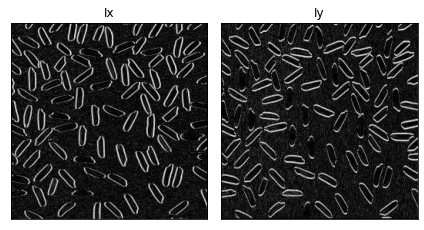
Step2: Second movement matrix M#
# Gaussian truncate window
kernel_size = 3
sigma = 0.5
Ixx = cv.GaussianBlur(Ix**2,(kernel_size,kernel_size), sigma)
Ixy = cv.GaussianBlur(Ix*Iy,(kernel_size,kernel_size), sigma)
Iyy = cv.GaussianBlur(Iy**2,(kernel_size,kernel_size), sigma)
Step3: Compute corner response function R#
offset = np.int8(kernel_size/2)
height, width = image.shape
corner_response = np.zeros((height, width))
# construct matrix elements
k = 0.02
for y in range(offset, height-offset):
for x in range(offset, width-offset):
A = np.sum(Ixx[y-offset:y+1+offset, x-offset:x+1+offset])
C = np.sum(Iyy[y-offset:y+1+offset, x-offset:x+1+offset])
B = np.sum(Ixy[y-offset:y+1+offset, x-offset:x+1+offset])
det = (A * C) - (B**2)
trace = A + C
R = det - k*(trace**2)
corner_response[y][x] = R
Step4: Corner response calculation and Non-maximum suppression#
# Response threshold 0.2*r_max
R_max = np.max(corner_response)
Threshold_mask = corner_response > 0.2*R_max
# Non max suppression mask
NMS_mask = (corner_response == maximum_filter(corner_response, 5))
mask = Threshold_mask & NMS_mask
keypoints = np.argwhere(mask==True)
# compare with open source library
# keypoints = corner_peaks(corner_harris(image), min_distance=5, threshold_rel=0.02)
Intermediate results visualization#
Show code cell source
plt.figure(figsize=(15, 15))
imgs = [Ix_8u, Iy_8u, Threshold_mask, mask, image]
titles = ['Ix', 'Iy', 'Thresholded corner response', 'Non-maximal suppression', 'Original image']
for i in range(5):
plt.subplot(3,2,i+1),plt.imshow(imgs[i],'gray')
plt.title(titles[i])
plt.xticks([]),plt.yticks([])
plt.subplot(3,2,6)
plt.imshow(imgs[-1], cmap=plt.cm.gray)
plt.plot(keypoints[:, 1], keypoints[:, 0], color='red', marker='o',
linestyle='None', markersize=2)
plt.title('Harris corners')
plt.xticks([]),plt.yticks([])
plt.tight_layout()
plt.show()
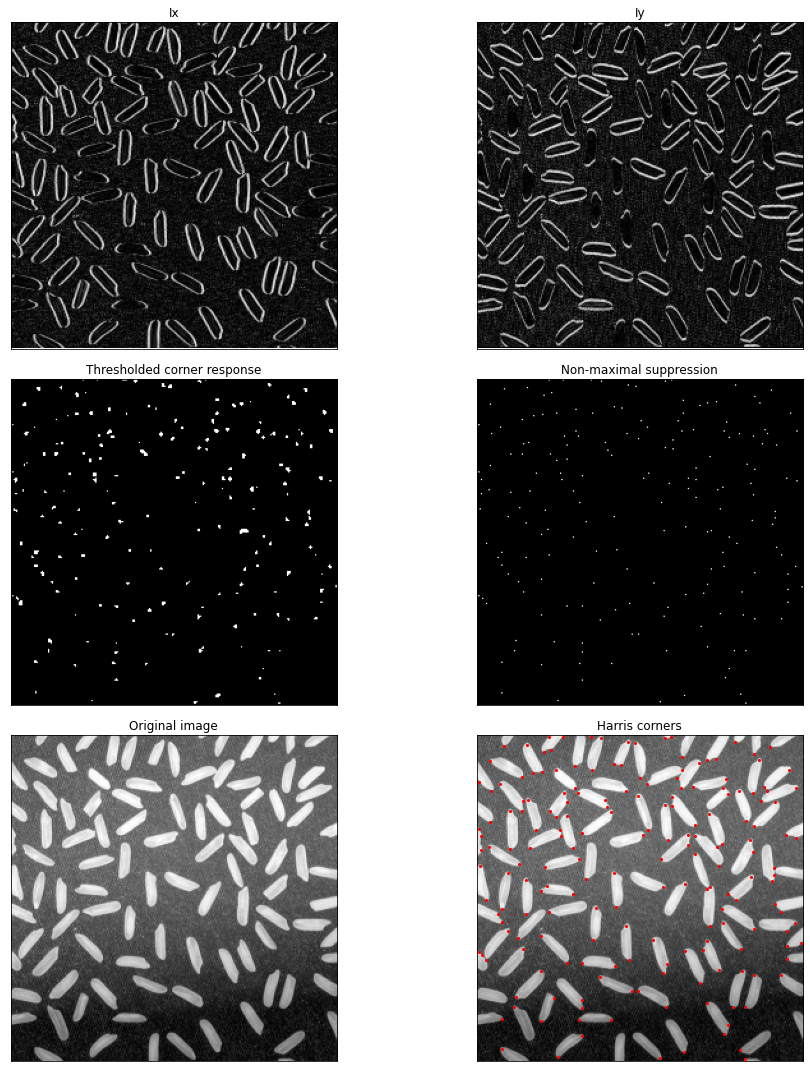
Invariance discussion#
Rotation invariance#
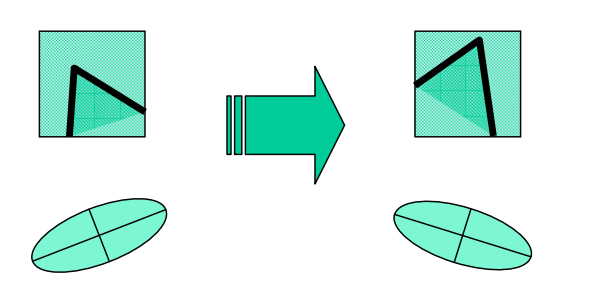
Corner response R is invariant to image rotation
Since Ellipse rotates but its shape (i.e. eigenvalues) remains the same.
Photometric transformations#
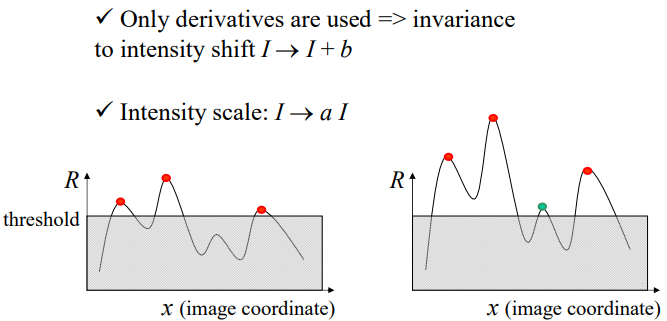
Partial invariance to additive and multiplicative intensity changes
Not invariant to changes in contrast.
Scale invariance#
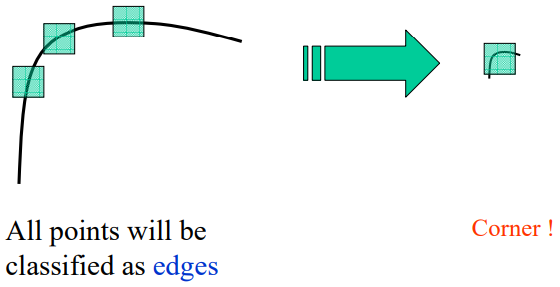
Not invariant to scaling
Blob detection with Laplacian kernel could solve this.

